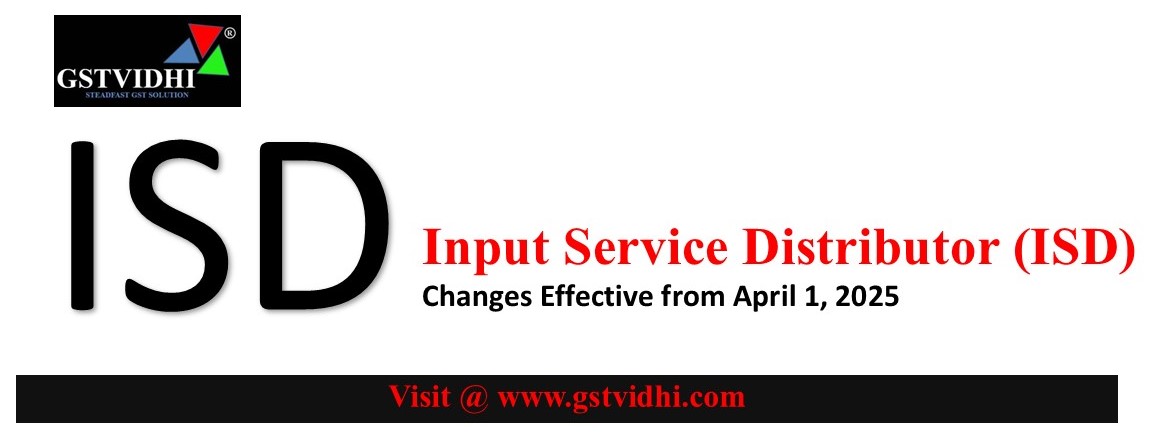
Input Service Distributor (ISD) in GST / What is ISD / Changes
Effective from April 1, 2025
Introduction
The concept of Input
Service Distributor (ISD) under the Goods and Services Tax (GST) is undergoing
a significant change effective from April 1, 2025. As per the amendments in
Section 20 of the Central Goods and Services Tax (CGST) Act, 2017, businesses
with multiple locations must register as ISD if they receive invoices for input
services that are used across different locations. This article simplifies the
concept of ISD, its implications, and how businesses can comply with the new
regulations.
Understanding ISD under
GST
Definition of ISD
As per Section 2(61) of
the CGST Act, 2017, an ISD is:
- An office of a taxpayer that receives
tax invoices for input services.
- This includes invoices under Reverse
Charge Mechanism (RCM).
- It distributes Input Tax Credit (ITC)
to distinct persons (branches or units of the same business).
- The ITC must be distributed as per
Section 20 of the CGST Act.
Thus, an office that
meets these criteria must register as an ISD from April 1, 2025.
ISD vs. Cross Charge
Key Differences
- ISD applies when
a business receives invoices for input services at a central office but
those services are used at multiple locations. The ITC is distributed
through ISD registration.
- Cross Charge applies when
services are consumed at one location and used to supply services to other
locations. In this case, the supplying unit must issue an invoice to the
recipient unit and charge GST.
Example
A company has an office
in Maharashtra and factories in Gujarat and Rajasthan. It purchases software
licenses for all three locations, but the invoice is issued in Maharashtra.
Since the software is used at all three locations, Maharashtra must register as
an ISD and distribute the ITC to Gujarat and Rajasthan.
If the Maharashtra office
also provides IT support to the other locations, it must issue invoices for
such services and charge GST under cross-charge.
How ISD Distributes ITC
Factors Determining ITC
Distribution
1. Location
of ISD vs. recipient unit
o If
both are in the same state, ITC is distributed as CGST & SGST.
o If
they are in different states, ITC is distributed as IGST.
o If
IGST is received, it remains IGST upon distribution.
2. Nature
of the tax (CGST, SGST, IGST)
o CGST
& SGST received must be distributed as CGST & SGST for the same state.
o CGST
& SGST received must be converted to IGST for different states.
Formula for Distribution
The ITC for each
recipient is calculated as:
C1=(t1/T)×CC1
Where:
- C1 = ITC for a
recipient
- C = Total ITC
to be distributed
- t1 = Turnover
of a recipient
- T = Total
turnover of all recipients
This means ITC is
distributed proportionally based on turnover.
Illustration
If ITC worth ₹1,00,000 is
to be distributed among three branches with turnovers of:
- Maharashtra: ₹50 lakh
- Gujarat: ₹30 lakh
- Rajasthan: ₹20 lakh
Then, the ITC
distribution will be:
- Maharashtra: 50/100×1,00,000=₹50,000
- Gujarat: 30/100×1,00,000=₹30,000
- Rajasthan: 20/100×1,00,000=₹20,000
Documentation
Requirements
ISD Invoice and Credit
Note
- ISD must issue an ISD invoice
while distributing ITC.
- If ITC needs to be reduced, an ISD
credit note must be issued.
Each ISD invoice/credit
note must contain:
- Name, address, and GSTIN of ISD.
- Serial number.
- Date of issue.
- Details of recipient and ITC amount.
- Digital or physical signature.
GST Compliance for ISD
Return Filing
- ISDs must file Form GSTR-6
every month, within 30 days from the end of the month.
- GSTR-6A
contains invoice details, which ISD can edit before finalizing GSTR-6.
Reporting by ITC
Recipients
- ISD-distributed ITC appears in Table
3, Part A, Section II of GSTR-2B.
- Recipients must report ITC in Table
4(A)(4) of GSTR-3B.
Conclusion
The revised ISD mechanism
is crucial for businesses with multiple locations to ensure proper ITC
distribution and avoid tax liabilities. With the mandatory ISD registration
from April 1, 2025, businesses should:
- Analyze their input service invoices.
- Identify whether they need ISD
registration.
- Ensure proper documentation and
compliance.
- Stay updated on further
clarifications by GST authorities
Disclaimer: All the Information is based on the notification, circular and order issued by the Govt. authority and judgement delivered by the court or the authority information is strictly for educational purposes and on the basis of our best understanding of laws & not binding on anyone.
Click here